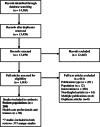Social media use among patients and caregivers: a scoping review
- PMID: 23667163
- PMCID: PMC3651969
- DOI: 10.1136/bmjopen-2013-002819
Social media use among patients and caregivers: a scoping review
Abstract
Objective: To map the state of the existing literature evaluating the use of social media in patient and caregiver populations.
Design: Scoping review.
Data sources: Medline, CENTRAL, ERIC, PubMed, CINAHL Plus Full Text, Academic Search Complete, Alt Health Watch, Health Source, Communication and Mass Media Complete, Web of Knowledge and ProQuest (2000-2012).
Study selection: Studies reporting primary research on the use of social media (collaborative projects, blogs/microblogs, content communities, social networking sites, virtual worlds) by patients or caregivers.
Data extraction: Two reviewers screened studies for eligibility; one reviewer extracted data from relevant studies and a second performed verification for accuracy and completeness on a 10% sample. Data were analysed to describe which social media tools are being used, by whom, for what purpose and how they are being evaluated.
Results: Two hundred eighty-four studies were included. Discussion forums were highly prevalent and constitute 66.6% of the sample. Social networking sites (14.8%) and blogs/microblogs (14.1%) were the next most commonly used tools. The intended purpose of the tool was to facilitate self-care in 77.1% of studies. While there were clusters of studies that focused on similar conditions (eg, lifestyle/weight loss (12.7%), cancer (11.3%)), there were no patterns in the objectives or tools used. A large proportion of the studies were descriptive (42.3%); however, there were also 48 (16.9%) randomised controlled trials (RCTs). Among the RCTs, 35.4% reported statistically significant results favouring the social media intervention being evaluated; however, 72.9% presented positive conclusions regarding the use of social media.
Conclusions: There is an extensive body of literature examining the use of social media in patient and caregiver populations. Much of this work is descriptive; however, with such widespread use, evaluations of effectiveness are required. In studies that have examined effectiveness, positive conclusions are often reported, despite non-significant findings.
Keywords: scoping review; social media.
Figures




References
-
- Hawn C. Take two aspirin and tweet me in the morning: how Twitter, Facebook, and other social media are reshaping health care. Health Affair 2009;28:361–8 - PubMed
-
- Allison M. Can web 2.0 reboot clinical trials? Nat Biotechnol 2009;27:895–902 - PubMed
-
- Bonilla-Warford N. Many social media options exist for optometrists. Optometry 2010;81:613–14 - PubMed
-
- Brownstein CA, Brownstein JS, Williams DS, et al. The power of social networking in medicine. Nat Biotechnol 2009;27:888–90 - PubMed
Publication types
LinkOut - more resources
Full Text Sources
Other Literature Sources
